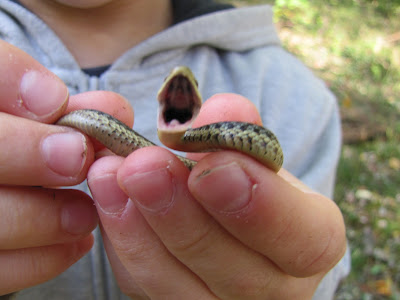So, here's what we found on a recent log rolling hike:
(1) Lots of leopard slugs (Limax maximus) also called giant garden slugs and their eggs.
These large noctural slugs devour fungi and dead plant matter as well as smaller slugs. Leopard slugs are hemaphrodites (they contain both male and female reproductive organs).
(4) Red efts (Notophtalmus viridescens) which represent one of the four stages of the life cycle of the red-spotted newt (egg - larvae - eft - adult). Efts are terrestrial juveniles that feed on spiders and other invertebrates. Like other brightly colored creatures, efts' bright orange skin warns predators of their toxicity.
(5) Baby garter snake (Thamnophis sirtalis) - this very young garter snake was one of several born during the last 2-3 weeks. A log provides a great hiding place from hawks, opossums and other predators as well as plenty of worms to eat. This little one was okay with being handled, but did not like the camera.
(6) Sow bugs or wood lice are actually crustaceans. Because they have gills, they need humidity to live. A wet rotting log not only provides moisture, but also the decaying matter which these isopods feed on.
(7) Common black ground beetles (Pterostichus melanarius) looking for soft-bodied prey such as maggots and caterpillars.
(8) Rove beetles looking for maggots, other insects and decaying matter.
(9) Beetle larvae or grubs
As you can see, there's plenty to discover under a log. Happy hunting and don't forget to put rolled logs back into their original position.

































































